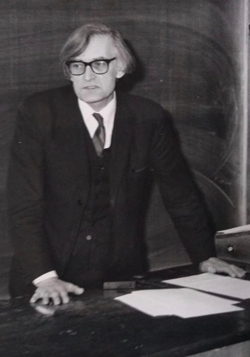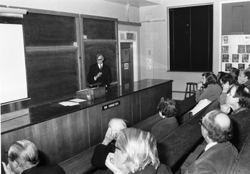An erudite polymath who brought mathematics to bear on palaeontology, John's choices of research foci were often ahead of their time

John Temple died at the age of 94 at his home in Oxford on May Day 2022, a date that would have appealed to his deep-rooted socialist principles. A subsequent celebration of his life brought together an appropriately eclectic group of friends and family to recall an archetypal university professor—a shy bibliophile who possessed a keen eye for identifying both important research questions and novel approaches to answering them.
Palaeontology
Born into a broadly working-class background, John experienced a peripatetic childhood, plagued by severe asthma. Nonetheless, in 1944 he won a scholarship to study Natural Sciences at St Catharine's College, Cambridge, his First-Class degree leading directly to doctoral research. John co-published his first paper in 1948, addressing the controversial contents of the "Neptunian dyke" near Ludlow. His doctorate established his career-long empirical roots in Late Ordovician and Early Silurian marine faunas, particularly of Wales, focusing initially on trilobites and later on brachiopods. The extensive series of taxonomic treatments that followed, most confined to the period 1965–1992, included three Palaeontological Society monographs that have stood the test of time, valuably informing subsequent biostratigraphic interpretations. John was also a founder member of the Palaeontological Association in 1957.
John was at his most impressive when innovating. As early as 1952 he was exploring trilobite ontogeny using quantitative methods, and later made impassioned pleas for standardising approaches to quantifying trilobite morphology. Arguably his greatest breakthrough came in 1977, when he published the first in a series of comparative studies of trilobites that employed multivariate statistical methods and best exploited his considerable mathematical skills. His palaeontological swansong, "The progress of quantitative methods in palaeontology" (1992), beautifully illustrated the breadth of John's knowledge but also revealed profound disappointment that his preferred geometric algorithms had been swamped by the parsimony that underlay increasingly popular cladistic studies—a frequent topic of debate between us.
Polymath

For almost his entire career, John was based in the Geology Department of Birkbeck College London, an institution whose ethos of adult education well-suited his altruistic worldview. His undergraduate lectures in palaeontology were predictably detailed, meticulously researched and hungrily devoured by evening-class students such as myself who were pre-adapted to the subject. John's research prowess and acquisition of a Cambridge DSc in 1983 saw him elevated to a well-deserved personal chair in 1984, but he soon found himself unexpectedly and reluctantly taking charge of the Department, following "a little local difficulty."
Unfortunately, the writing was already on the wall for the direct, principled styles of both academic and political engagement in which John so passionately believed, and he retired with some relief in 1992. Having earlier applied his multivariate skills to linguistic analysis of Plato's collected works, John spent much of his long retirement compiling the definitive dictionary of ancient Greek idioms—a project that continued to integrate the many skills of this remarkable polymath.
Pre-deceased by his beloved wife Dorothy, John is survived by their children, Jane and Richard.
By Richard M. Bateman
In both pictures above, John Temple giving his inaugural lecturer as a professor at Birkbeck College in February 1986.